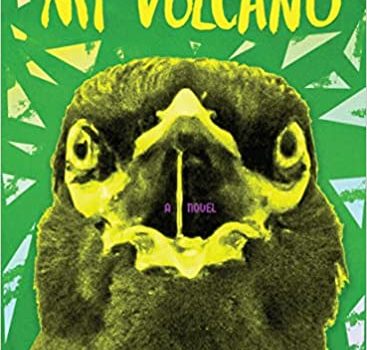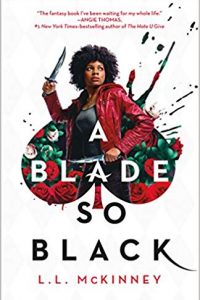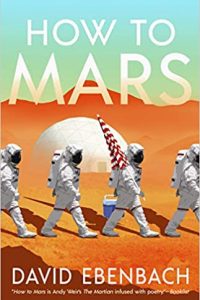Ian Mond Reviews My Volcano by John Elizabeth Stintzi
 My Volcano, John Elizabeth Stintzi (Two Dollar Radio 978-1-95338-716-5, $12.95, 330pp, tp) March 2022.
My Volcano, John Elizabeth Stintzi (Two Dollar Radio 978-1-95338-716-5, $12.95, 330pp, tp) March 2022.
John Elizabeth Stintzi’s second novel, My Volcano, begins in the early hours of June 2, 2016, with a volcano ‘‘sprouting from the middle of the reservoir in Central Park.’’ On that first morning, the volcano is only eight feet high; within a week it has swallowed up Central Park, and ‘‘by June 23, the day the volcano reached its apex, the vibrations had destroyed most of the buildings in the city. The death toll was in the thousands.’’ Stintzi’s absurdist premise would provide more than enough grist for an off-beat disaster novel, but they have larger aspirations than to reduce New York to rubble. As My Volcano unfurls outward, growing more surreal and bizarre, leading to eruptions both figurative and literal, it becomes a story about our struggle to connect with those we love and the planet we seem hellbent on destroying.
Across its 232 chapters, many of them less than a page long, Stintzi introduces us to a large cast of characters. Some, such as the child born with the face of a bull or the husband who turns his deflated wife’s body into a human kite, appear only briefly. Others, however, gradually emerge as the key players in the novel. There’s Angel Barros Vargas, an eight-year-old boy from Mexico City who accidentally travels back six centuries to the Aztec Empire; and nomadic herder Dzhambul, with his horse Od, whose body blossoms with white and purple flowers after he is stung by a bumblebee. Over in Japan, we encounter Nigerian academic Dr. Duncan Olayinka and learn about his research into a folktale common across multiple cultures of a woman who journeys down from the peak of a volcano to destroy the first city she visits. Olayinka’s partner, Dr. Aithne Elgin, has travelled with a group of geologists to New York to investigate and chart the growth of the Central Park volcano. Nearby, a white trans writer, travelling on the subway, imagines Gish, the protagonist of their novel, and his attempts to contact the inhabitants of exoplanet ‘‘Vulca-9D.’’ While in Hawaii, advertising executive Ash Griffis is stunned to discover that he has a doppelgänger doing his job in New York. Watching over these individuals, and several others I haven’t mentioned because there isn’t the room, are the enigmatic Otherwise who seem poised to cast their judgement on humanity.
Just over the halfway mark of My Volcano, the white trans writer receives feedback from their thesis advisor about their manuscript.
She didn’t think the book worked. There was too much going on between the two stories…. The reader got lost in the movement – the whiplash – between the two narratives, and readers of a book should never be lost.
This chuckle-worthy moment (well, not so much for the white trans writer) pokes fun at the ‘‘whiplash’’ structure of My Volcano, while also being a sly critique of those who believe that fiction (and art more broadly) should be easily digestible and understood. Akin to Isabel Waidner and Jenny Hval, two marvellous writers whose surrealist work defies categorisation, Stintzi doesn’t concern themselves with the reader’s ability to keep up. Instead, they adopt a style that suits the story, a style reflective of volcanoes and seismic activity – unstable, fluid and constantly shifting underfoot.
This isn’t to say that the novel is difficult to understand. The appearance of a volcano in Central Park, coupled with a Mongolian herder mutating into a mobile version of Jeff VanderMeer’s Area X, and a Golem (yes, a Golem), destroying the heavy industry polluting the environment, loudly signposts Stintzi’s views on how poorly we have mistreated the planet. In the same vein, the novel’s disjointed structure – the short chapters, the frequent changes of scenery, the introduction of new characters – reinforces the disconnection and isolation felt by the characters. Take the relationship between Drs. Olayinka and Elgin, who, from the first time we meet them, are split apart geographically – one in Japan, the other in New York. While they both care for each other, they ‘‘were never in the same place long enough to get in sync,’’ resorting to a 24/7 livestream of their apartment or hotel room to create a facsimile of closeness or intimacy. Duncan and Aithne are not alone. All the relationships described in the novel are separated geographically, whether it’s Therese – a colleague of Ash – pining for her ex-girlfriend Makayla who has moved back to San Francisco, or Ash debating whether he should tell Joao, a young astronomer in Chile, that he has a crush on him – even loves him.
What I found most profound about My Volcano is that it’s set in 2016. For a couple of years now, I’ve viewed 2016 as an inflection point in history, the year time travellers would choose to divert us from the darkest timeline. With the emergence of the volcano in Central Park, I got the impression that Stintzi holds a similar view, that for the species 2016 was the year when a critical mass was reached, a line was crossed. This is underscored by a series of brief interruptions to the narrative, like notes on a bulletin board, of the cruel, sudden death of a marginalised person. These moments of violence – including the naming of 49 people who Omar Mateen slaughtered at the Pulse nightclub in Orlando – all, horribly, occur between June and August 2016. My Volcano might be steeped in the strange, the absurd, and the esoteric, but Stintzi’s care for the planet and their desire for us all to be better than we are couldn’t be any more lucid and direct.
Ian Mond loves to talk about books. For eight years he co-hosted a book podcast, The Writer and the Critic, with Kirstyn McDermott. Recently he has revived his blog, The Hysterical Hamster, and is again posting mostly vulgar reviews on an eclectic range of literary and genre novels. You can also follow Ian on Twitter (@Mondyboy) or contact him at mondyboy74@gmail.com.
This review and more like it in the May 2022 issue of Locus.
 While you are here, please take a moment to support Locus with a one-time or recurring donation. We rely on reader donations to keep the magazine and site going, and would like to keep the site paywall free, but WE NEED YOUR FINANCIAL SUPPORT to continue quality coverage of the science fiction and fantasy field.
While you are here, please take a moment to support Locus with a one-time or recurring donation. We rely on reader donations to keep the magazine and site going, and would like to keep the site paywall free, but WE NEED YOUR FINANCIAL SUPPORT to continue quality coverage of the science fiction and fantasy field.
©Locus Magazine. Copyrighted material may not be republished without permission of LSFF.








